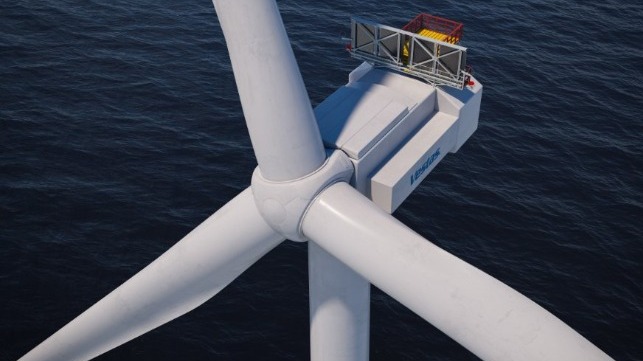NUKE NEWZ
Moltex recycling process granted Canadian patent
15 January 2024
The patent covers Moltex Energy Canada's Waste To Stable Salt (WATSS) process for converting any uranium oxide fuel into molten salt reactor fuel, part of a suite of technologies being developed by the company alongside its Stable Salt Reactor - Wasteburner (SSR-W) fast reactor and GridReserve thermal energy storage system.
.jpg?ext=.jpg) The company's vision for a site all three of its technologies - WATTS recycling, SSR-W reactor and GridServe thermal energy storage(Image: Moltex)
The company's vision for a site all three of its technologies - WATTS recycling, SSR-W reactor and GridServe thermal energy storage(Image: Moltex)The process was invented by Ian Scott, Moltex's co-founder and chief scientist. It involves the conversion of used nuclear fuel into products and by-products: transuranics, along with some uranium and fission products, are extracted into a salt which forms the fuel for the SSR-W reactor and some other reactors; uranium - a major by-product - which is considered as intermediate to low level radioactive waste, but can also have other uses; and fission products, a byproduct which can be disposed directly or used as a heat source for remote applications.
Unlike conventional reprocessing routes, the WATSS process is unable to produce pure plutonium which could be misused for "nefarious purposes", the company said. As well as removing this proliferation risk, this also makes it simpler and less expensive than conventional reprocessing, it added.
Moltex CEO Rory O'Sullivan said the patent is testament to Moltex's commitment to innovation and to finding improvements in existing nuclear energy processes. “Waste is one of the most important considerations in the nuclear industry, and Moltex’s process offers an elegant and cost-effective solution to safely reducing waste stockpiles,” he added.
Moltex is aiming to deploy first-of-a-kind SSR-W, WATSS and GridReserve units at NB Power's Point Lepreau site in New Brunswick, where an existing Candu reactor is expected to retire around 2040.
Sizewell C project to enter construction phase
15 January 2024
The Sizewell C nuclear power plant project has been awarded a Development Consent Order (DCO), paving the way for formal construction work to begin at the site in Suffolk, UK.
.jpg?ext=.jpg) Sizewell C (Image: EDF Energy)
Sizewell C (Image: EDF Energy)
EDF Energy submitted a DCO for the plant in May 2020. The DCO - which is from the nuclear site licence application - is considered by the Planning Inspectorate, which determines if the overall proposed scheme is acceptable under national planning legislation. The project was granted permission by the Planning Inspectorate to build in July 2022. However, while preparatory works subsequently began, many obligations needed to be satisfied before construction could commence under its DCO
Those obligations, set out in a Deed of Obligation document signed with East Suffolk Council and Suffolk County Council, and which included activity ranging from key road surveys to the establishment of Governance Groups, are all now satisfied and the formal construction phase of the project can begin, EDF Energy has announced.
By commencing formal construction, a GBP250 million (USD318 million) package of funding for the local community will become available in phases during the construction phase of the project. That funding includes GBP23 million for community projects, GBP100 million for the environment, GBP12 million to support local tourism, and a GBP12 million housing fund to boost private housing and tourist accommodation.
To ensure local people continue to have their say on the project during construction, new Sizewell C Forums have launched so that residents can discuss key issues with the project team. There are four main forums, chaired independently, covering all the main project-related topics relevant to the community. Parish and town councils will represent the community at the forums, and local people can attend the meetings as observers.
In September 2023, the UK government, Sizewell C and EDF launched an equity raise process to attract private investors into the project. While triggering the DCO and entering the construction phase is not dependent on a final investment decision (FID), constructive discussions with qualified potential investors are continuing and an FID is expected later in 2024.
"This is a significant moment for our project in Suffolk and a big step for British energy security," Julia Pyke and Nigel Cann, Joint Managing Directors at Sizewell C, said. "We've had a really successful year of pre-commencement works on site, and we've been working hard with local partners and organisations to ensure we're ready to take this next step for the project.
"While Sizewell C will be a linchpin of Britain's energy system, it's much more than a power station, especially for this region. Entering the construction phase will be a game-changer for the area, helping to boost employment and skills, enhancing the local environment, and developing new clean technologies."
Nuclear Minister, Andrew Bowie, visiting the Sizewell C construction site, said: "This is a major milestone for Sizewell C and our ambition to deliver up to 24 GW of low-carbon nuclear power by 2050. It comes after we announced the biggest expansion of nuclear power for 70 years which will help to bring down bills and bolster our energy security. East Anglia will benefit from thousands of new jobs and apprenticeships as a result, demonstrating the local rewards of backing new nuclear."
"Today's commencement of formal construction is good news for Britain," added Tom Greatrex, Chief Executive of the Nuclear Industry Association. "Construction at Sizewell C means tens of thousands of jobs on site and across the country and potentially billions in investment for the region. The project will drive much needed work into British industry and sustain the skills we need for a new nuclear programme. Sizewell lays that foundation for jobs, clean power and energy security for the rest of this century."
The plan is for Sizewell C to feature two EPRs producing 3.2 GW of electricity, enough to power the equivalent of around six million homes. It would be a "replica" of the Hinkley Point C plant, under construction in Somerset.
"Sizewell C will deliver 1500 apprenticeships and support thousands of jobs across the country, with at least one-third of the peak construction workforce of 7900 coming from the local area," Sizewell C said. "The project will invest in local skills to ensure there is a pipeline of talent ready, not only to build and operate Sizewell C, but to support the UK's future nuclear ambitions. The project will also have a transformational impact on local supply chains."
Key safety component installed at Sanmen 3
15 January 2024
The first of two core makeup tanks has been successfully hoisted into place at unit 3 of the Sanmen nuclear power plant in China's Zhejiang province. The tanks are an important part of the CAP1000 reactor's passive safety system.
.jpg?ext=.jpg) The core makeup tank B at Sanmen 3 (Image: SNERDI)
The core makeup tank B at Sanmen 3 (Image: SNERDI)
Each CAP1000 unit contains two water replenishment tanks, A and B. They are mainly used to provide boronated water in the event of an accident to ensure the effectiveness of core decay heat removal.
The core water supply tank B was installed at Sanmen 3 on 11 January, the Shanghai Nuclear Engineering Research and Design Institute (SNERDI) announced.
"Due to the complex installation environment of the core water tank, which is surrounded by multiple modular steel beams and structural embedded parts, SNERDI conducted a comprehensive analysis of the hoisting risks in advance and formulated solutions," it said. "Three-dimensional simulation was used to identify and remove interference items on the hoisting path to ensure safe and efficient hoisting work; at the same time, innovate construction technology and milling machines were used to process in blocks and match them with pads of corresponding sizes to effectively solve the flatness of the foundation in place."
The CAP1000 reactor design - the Chinese version of the AP1000 - uses modular construction techniques, enabling large structural modules to be built at factories and then installed at the site. This means that more construction activities can take place at the same time, reducing the time taken to build a plant as well as offering economic and quality control benefits.
The construction of two new reactors at each of the Sanmen, Haiyang and Lufeng sites in China was approved by China's State Council in April 2021. The approvals were for Sanmen units 3 and 4, Haiyang 3 and 4 and units 5 and 6 of the Lufeng plant. The Sanmen and Haiyang plants are already home to two Westinghouse AP1000 units each, and two CAP1000 units were approved for Phase II (units 3 and 4) of each plant.
The CAP1000 reactor design - the Chinese version of the AP1000 - uses modular construction techniques, enabling large structural modules to be built at factories and then installed at the site.
The first safety-related concrete was poured for the nuclear island of Sanmen 3 on 28 June 2022, marking the official start of its construction. The first concrete for that of unit 4 was poured on 22 March 2023.
Supply chain issues prompt Kazatomprom to adjust production plans
12 January 2024
The Kazakh national atomic company expects to adjust its 2024 production guidance due to factors including the availability of sulphuric acid and delays in completing construction works at newly developed deposits, although it remains committed to its delivery obligations for the year.
.jpg?ext=.jpg) In-situ leach operations at Kazatomprom's Akbastau joint venture (Image: Kazatomprom)
In-situ leach operations at Kazatomprom's Akbastau joint venture (Image: Kazatomprom)
In August 2022, Kazatomprom said it planned to increase its 2024 uranium production to a 90% level relative to its subsoil use agreements - an increase of 2000-3000 tU above expected 2023 levels, which were 80% relative to subsoil use agreements. This decision was based primarily on mid- and long-term contracts signed with new and existing customers and would have been the highest production level relative to subsoil contracts since the company's 2017 decision to flex down production from 2018 in response to supply and demand considerations.
The company has continued to note that challenges related to global supply chains and limited availability of certain key operating materials and reagents would pose a risk to planned production increases.
With growing demand from agricultural and industrial enterprises and shortages on both domestic and foreign regional markets, preliminary agreements with suppliers resulted in the company securing lower than required volume of sulphuric acid for 2024, Kazatomprom said today. It is "actively pursuing" alternative supplies of the reagent, which is used as the oxidant in its in-situ leach uranium operations, but current projections indicate that achieving its planned production levels "may be challenging".
The exact impact is still being assessed, and will be detailed in Kazatomprom's next quarterly trading update which is due by 1 February. If the issues continue throughout this year, 2025 production plans may also be affected, it said.
Utility invests USD10 million in advanced reactor feasibility study
12 January 2024
Puget Sound Energy - the oldest and largest utility in Washington State - is contributing USD10 million towards the feasibility stage of Energy Northwest's programme to develop and deploy a next-generation nuclear energy facility. Energy Northwest has already determined that X-energy's Xe-100 advanced small modular reactor (SMR) is the most suitable design to meet the region's specific needs.
.jpg?ext=.jpg) Energy Northwest's Columbia plant, shown here, recently entered its 20-year period of extended operation and is licensed to operate until 2043. (Image: Energy Northwest)
Energy Northwest's Columbia plant, shown here, recently entered its 20-year period of extended operation and is licensed to operate until 2043. (Image: Energy Northwest)
State polices requiring a "substantial increase" in clean electricity are leading utilities to evaluate potential sources of new clean energy generation, Energy Northwest said. New nuclear energy technologies, such as advanced SMRs, are approaching commercial readiness and feature enhanced safety systems; simplified, standardised, and scalable designs; and the ability to both swiftly integrate with renewables and provide around-the-clock electricity without producing any greenhouse gas emissions, it added.
The USD10 million that Puget Sound Energy has agreed to invest in the programme will supplement some USD10 million contributed to date by Energy Northwest and supporting entities, which includes nearly USD1 million of combined investment from 17 other public utilities.
"As we decarbonise the electric grid, it is increasingly evident new sources of carbon-free, reliable, and affordable electricity must be deployed - and advanced nuclear energy technology can play a vital role in this transition," said Energy Northwest CEO Bob Schuetz. "Energy Northwest's partnership with Puget Sound Energy underscores our shared commitment to address the climate challenge and meet the region's future clean energy needs with the help of new and innovative carbon-free nuclear energy technologies."
"Our clean energy future depends on finding reliable resources that produce energy when customers need it without emitting greenhouse gases," said Mary Kipp, president and CEO of Puget Sound Energy. "Advanced nuclear technology has the potential to be that resource."
The Xe-100 SMR is an 80 MWe high-temperature gas cooled reactor which uses TRISO (tristructural isotropic) particle fuel. A joint development agreement signed in July between Energy Northwest and X-Energy Reactor Company envisages the deployment of up to 12 Xe-100 units at a site adjacent to the existing Columbia nuclear power plant, with the first module expected to be online by 2030.
Energy Northwest is a joint operating agency set up by the state legislature in 1957, with 28 public power member utilities serving more than 1.5 million customers. It owns and operates the region's only nuclear power plant, the Columbia Generating Station, as well as solar, hydroelectric and wind generating facilities and a battery energy storage system. Puget Sound Energy owns over 3500 MWe of generating capacity, including hydroelectric, wind and thermal plants.
Washington is committed to making its electricity supply completely free of greenhouse gas emissions by 2045, under a law signed in 2019.
NRC approves HALEU transport package
12 January 2024
NAC International's patented Optimus-L packaging system to contain and transport high-assay low-enriched uranium (HALEU) TRISO fuel has been approved by the US Nuclear Regulatory Commission (NRC). Such fuel will be used in advanced reactors.
.jpg?ext=.jpg) Optimus-L packages (Image: NAC)
Optimus-L packages (Image: NAC)
The NRC issued a Certificate of Compliance (CoC) on 14 December, enabling NAC with the Optimus-L system (packaging and contents) to transport HALEU TRISO fuel compacts to support an advanced reactor project for a undisclosed customer.
"This is the first time the NRC has licensed high-capacity packagings (>500 lb payload) for HALEU TRISO fuel in the US and lays the foundation for future licensing of NAC's Optimus systems to carry other HALEU contents," NAC noted.
TRISO fuel comprises spherical kernels of enriched uranium oxycarbide (or uranium dioxide) surrounded by layers of carbon and silicon carbide, giving a containment for fission products which is stable up to very high temperatures. HALEU TRISO fuels are being considered as the preferred fuel in several advanced reactor designs currently under development.
The Optimus-L is a lightweight, versatile and modular nuclear materials packaging system first licensed by the NRC in December 2021. NAC developed Optimus as a platform that can be easily expanded and optimised for multiple types of nuclear materials using the company's proprietary methodologies. NAC said it plans on leveraging this platform to include a range of HALEU forms and design configurations to support future HALEU material packaging and transportation projects.
"The approval of high-capacity packaging systems like Optimus-L for these types of fuel supports the development of a robust HALEU infrastructure to ensure material movement is not a limiting factor in modern nuclear power development," NAC said. "When compared to smaller capacity drum packages that would require an excessive number of packagings and significantly more handling effort per conveyance trailer, the Optimus-L offers a highly competitive solution to economically ship commercial quantities of HALEU materials with fewer packagings."
"We are pleased to achieve this milestone - NRC certification for our unequaled Optimus-L system to incorporate HALEU TRISO contents," said NAC President and CEO Kent Cole. "Receiving this CoC supports our objective of offering high-capacity and high-efficiency HALEU transportation to support commercial shipments.
"This amendment opens the door for other future HALEU contents in the Optimus-L platform. This certification is an important milestone on our HALEU packaging technology roadmap, and by offering efficient HALEU packaging and transportation, we are doing our part to help build a robust HALEU fuel cycle."
Molten salt test system reaches operational milestone
11 January 2024
Kairos Power has successfully completed 1000 hours of pumped salt operations with its non-nuclear Engineering Testing Unit (ETU). The unit, loaded with 12 tonnes of Flibe salt, is the largest Flibe system ever built and will inform the design, construction, and operation of the Hermes low-power demonstration reactor.
-Albuquerque-(Kairos).jpg?ext=.jpg) ETU 1.0 (Image: Kairos)
ETU 1.0 (Image: Kairos)
Flibe is a chemically stable mixture of lithium, fluorine, and beryllium that will be used as the coolant for Kairos's fluoride salt-cooled high-temperature reactor, the KP-FHR. The company is following an iterative approach to development: the non-nuclear ETU was built at the company's testing and manufacturing facility in Albuquerque, New Mexico, to demonstrate the design and integration of key systems, structures, and components, exercise the supply chain, and accelerate the company's experience with large-scale Flibe operations.
Kairos produced 14 tonnes of Flibe for the ETU at the Molten Salt Purification Plant MSPP in Elmore, Ohio, in partnership with Materion Corporation, itself the first plant ever built to produce Flibe at an industrial scale. The Engineering Testing Unit has also catalysed the development of other critical infrastructure for Kairos Power, the company said, as well as initiating the supply chain for specialised materials and components, and so mitigating development risk.
Kairos said it was collecting "an abundance of data" from the ETU operations, which have included amongst other things the removal and inspection of surrogate fuel pebbles via the integrated Pebble Handling and Storage System to demonstrate the feasibility of online refuelling and commissioning a first-of-its-kind chemistry control system to continuously monitor the purity of the molten salt circulating inside the unit. The system is continuously monitored from two control rooms, one co-located with ETU in Albuquerque and one at the company's headquarters in Alameda, California.
"Gaining experience with Flibe production and operations is fundamental to taking risk off the table towards KP-FHR commercialisation," Kairos Power co-founder and CEO Mike Laufer said. "Iterative development with real hardware systems like ETU 1.0 is a pillar of our strategy to deliver a clean, safe, affordable technology with true cost certainty, and, when combined with in-house manufacturing, provides a unique opportunity to move quickly so we can make an impact in the fight against climate change."
The ETU began operations in the autumn and is expected to run for about five months. Once testing is complete, this first iteration of the ETU - ETU 1.0 - will be decommissioned to make way for ETU 2.0, which will demonstrate modular construction. A final iteration, ETU 3.0, will be built adjacent to the Hermes site in Oak Ridge, Tennessee.
The US Nuclear Regulatory Commission recently approved Kairos's application to build Hermes, a 35 MW (thermal) non-power version of the KP-HFR, with the company aiming to begin construction this year.
Learnings from the ETU will inform the Hermes demonstration reactor project (Video: US Department of Energy)
UK releases roadmap to quadruple nuclear energy capacity
11 January 2024
The British government has launched a roadmap for reaching its ambition for the UK to have 24 GWe of nuclear generating capacity by 2050, representing about 25% of the country's projected electricity demand.
.jpeg?ext=.jpeg) Hinkley Point C is currently the only new nuclear power plant under construction in the UK (Image: EDF Energy)
Hinkley Point C is currently the only new nuclear power plant under construction in the UK (Image: EDF Energy)
It said the Civil Nuclear Roadmap "outlines plans for the biggest expansion of nuclear power for 70 years to reduce electricity bills, support thousands of jobs and improve UK energy security - including exploring building a major new power station and investing in advanced nuclear fuel production".
Nuclear's share of energy in the UK is currently about 16%, however all but one of its existing reactors are due to retire by 2030.
The roadmap "will give industry certainty of the future direction of the UK's ambitious nuclear programme, on top of the government's historic commitment to Sizewell C and world-leading competition to develop small modular reactor (SMR) technology," the government said.
The plans include next steps for exploring a large-scale nuclear power plant as well as SMRs. The roadmap also includes a government ambition to secure 3–7 GW worth of investment decisions every five years from 2030 to 2044 on new nuclear projects.
According to the government, plans to streamline the development of new nuclear power plants and introduce smarter regulation could speed up the overall process and, as a result, the delivery of nuclear power in the UK. This includes allowing regulators to assess projects while designs are finalised, and better cooperation with overseas regulators assessing the same technology.
Earlier this week, the government announced it will also invest up to GBP300 million (USD381 million) in UK production of high-assay low-enriched uranium (HALEU), which is currently only commercially produced in Russia. HALEU - uranium enriched to between 5% and 20% uranium-235 - will be used in the advanced nuclear fuel required for most of the next-generation reactor designs currently under development.
The government has also published two consultations, one on a new approach to siting future nuclear power plants and another on supporting the sector and encouraging private investment to roll out advanced nuclear projects. The proposals aim to "attract investment in the UK nuclear sector by empowering developers to find suitable sites rather than focusing on eight designated by government".
The roadmap says: "The coming years are expected to bring further clarity on the costs and effectiveness of new nuclear technology. This may require us to re-evaluate some of our strategies and policies for the long term. To take account of these developments, we therefore intend to publish a Roadmap 'update' by the end of 2025."
"Nuclear is the perfect antidote to the energy challenges facing Britain - it's green, cheaper in the long term and will ensure the UK's energy security for the long-term," said Prime Minister Rishi Sunak. "This is the right long-term decision and is the next step in our commitment to nuclear power, which puts us on course to achieve net-zero by 2050 in a measured and sustainable way. This will ensure our future energy security and create the jobs and skills we need to level up the country and grow our economy."
Secretary of State for Energy Security and Net Zero Claire Coutinho added: "We're making the biggest investment in domestic nuclear energy in 70 years ... From large gigawatt projects to small modular reactors, the UK's wider nuclear revival will quadruple our nuclear capacity by 2050 – helping to power Britain from Britain."
"The government's investment in nuclear will ensure the UK remains at the forefront of technological developments," said Minister for Nuclear Andrew Bowie. "Our plans will give investors the confidence to back new UK projects, with a simpler process for locating new schemes and clear support for private sector companies developing innovative new technologies."
Simon Bowen, chairman of Great British Nuclear, the arms-length body designed to drive the delivery of new nuclear energy projects in the UK, welcomed the roadmap and the consultations on siting - especially in the context of the UK's current small modular reactor selection process - and alternative routes to market.
He said: "It's a very comprehensive document, a great step forward and a step in the right direction for forming the UK's new nuclear programme, which we will be accountable for delivering alongside our colleagues in Sizewell and Hinkley."
The release of the roadmap was welcomed by industry, with Tom Greatrex, Chief Executive of Nuclear Industry Association, saying: "We will need both large and small nuclear at scale and at pace for our energy security and net-zero future. Allowing developers to engage with the government about Regulated Asset Base funding models should also make it cheaper to finance projects, cutting costs to the consumer. Decisions on 3-7 GW in each five year period provide the greater clarity and predictability, which in turn enables supply chain investment and more UK content in the future fleet.
"The commitments to maximise our use of regulatory assessments already undertaken overseas will help get innovative reactor designs into construction faster and reduce the duplication in regulatory activity that eats up time for no additional benefit."
World Nuclear Association Director General Sama Bilbao y León added: "The UK government’s roadmap to streamline the process of future nuclear development and quadruple nuclear energy in the UK by 2050 is a pragmatic example of the positive action now being taken to deliver on the commitments made by those countries that endorsed the net zero nuclear Ministerial Declaration to Triple Nuclear Energy at COP28. The UK was a founding government partner of our Net Zero Nuclear initiative and I welcome today’s announcement."
IAEA sees 'significant progress' in Kenya's research reactor preparations
11 January 2024
Kenya is pursuing the development of the country's first research reactor, a stepping stone towards a future nuclear power programme, and invited an International Atomic Energy Agency (IAEA) mission to review the development of its national nuclear infrastructure.

Andrey Sitnikov, who led the Integrated Nuclear Infrastructure Review for Research Reactors Mission and is the technical lead of the IAEA Research Reactor Section, said: "Kenya has demonstrated a sustained and very professional approach to the development of its research reactor programme. We noted that before making the final decision, Kenya did a great job of developing and preparing laws and regulatory documents, actively involving interested stakeholders in the programme, and developing human resources of both the future operator and the regulator."
The eight-member mission team, from India and the USA and six IAEA staff members, conducted the nine-day mission in December, reviewing the status of the country's nuclear infrastructure development against the Phase 1 criteria from the IAEA's Milestones Approach, which provides guidance for the preparation of a research reactor project on 19 issues ranging from nuclear safety and waste managements to financing.
The mission team provide recommendations and suggestions for the further development of nuclear infrastructure. Kenya plans to commission its first research reactor in the early 2030s. In September 2023 the Nuclear Power and Energy Agency (NuPEA) announced a potential project for a 1000 MWe nuclear plant located in either Kilifi or Kwale.
NuPEA said that following receipt of the mission team's report an Integrated Action Plan would be developed to address the recommendations and suggestions made. It added that the mission "underscores Kenya’s unwavering commitment to transparency and cooperation in advancing nuclear technology for peaceful purposes. The insights gained from this review will propel the country toward achieving Kenya’s goals of harnessing the potential of nuclear energy safely and responsibly."
Researched and written by World Nuclear News



